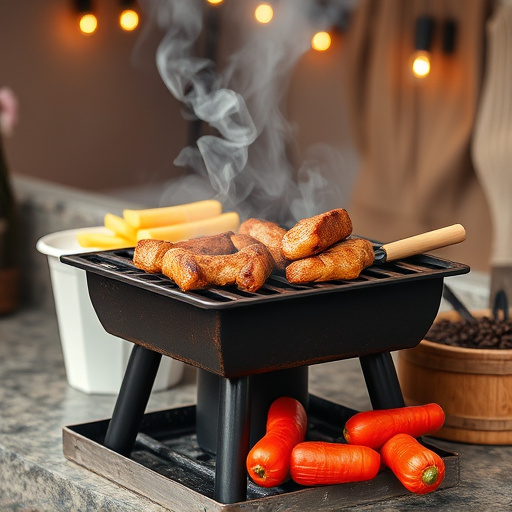Selecting the right cut, understanding brisket anatomy, and using dry brining transform tough brisket into a melt-in-your-mouth delicacy for your Smoked BBQ Brisket Recipe. Choosing the ideal smoker (charcoal, gas, or electric) and maintaining precise temperature control between 225°F to 250°F (107°C to 121°C) is crucial for even cooking. Experimenting with wood chips like oak, hickory, mesquite, and applewood adds unique flavors. Resting the brisket for at least an hour per pound after smoking ensures maximum tenderness. Slicing it thinly across the grain before serving showcases its beauty and enhances the overall dining experience.
“Unleash your inner BBQ master with our ultimate guide to achieving smoked brisket perfection. From selecting the right cut, understanding brisket anatomy for optimal smoking, and mastering dry brining techniques, we’ll walk you through every step. Learn which smoker suits your needs—charcoal, gas, or electric—and discover the art of smoke temperatures and wood chips. We’ll reveal the secrets to resting your brisket for maximum tenderness and provide expert tips on slicing and serving. Elevate your smoked BBQ brisket recipe with these proven techniques.”
- Selecting the Right Cut: Understanding Brisket Anatomy for Optimal Smoking
- Dry Brining: The Key to Infusing Flavor and Tenderizing Your Brisket
- Choosing the Best Smoker: Charcoal, Gas, or Electric for Consistent Results
- Mastering Smoke Temperatures: Finding the Sweet Spot for Slow-Cooked Delicacy
- The Art of Wood Chips and Smoking Times: A Guide to Achieving That Smoked Flavor
- Resting Your Brisket: Why It's Crucial for Maximum Tenderness
- Slicing and Serving: Techniques for Presenting a Perfectly Cooked Brisket
Selecting the Right Cut: Understanding Brisket Anatomy for Optimal Smoking
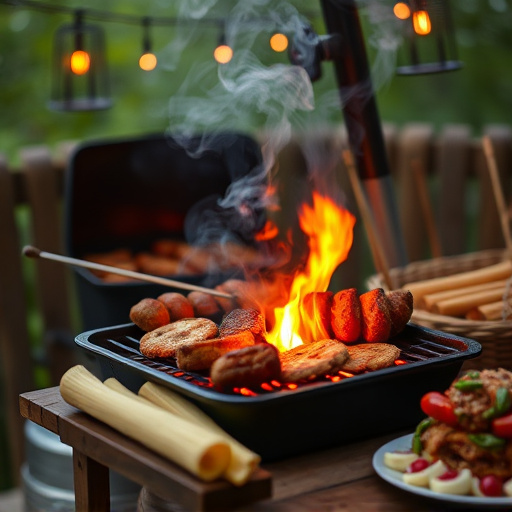
When it comes to achieving tender, smoked brisket perfection in your BBQ recipe, selecting the right cut is half the battle won. The brisket, often referred to as the ‘crown jewel’ of BBQ, has two distinct muscles: the leaner, more flavorful flat and the richer, marbled point. For optimal smoking, choose a cut that includes both these muscles, known as a full packer brisket. This allows for even cooking and ensures you get the best of both flavors in every bite of your smoked BBQ brisket recipe.
Understanding brisket anatomy is key to success. The flat muscle is responsible for the meat’s tenderness, while the point provides rich, smoky flavor. By cutting along the natural lines of the muscle, you can maintain the integrity of each section, resulting in a more well-balanced and delicious smoked BBQ brisket.
Dry Brining: The Key to Infusing Flavor and Tenderizing Your Brisket
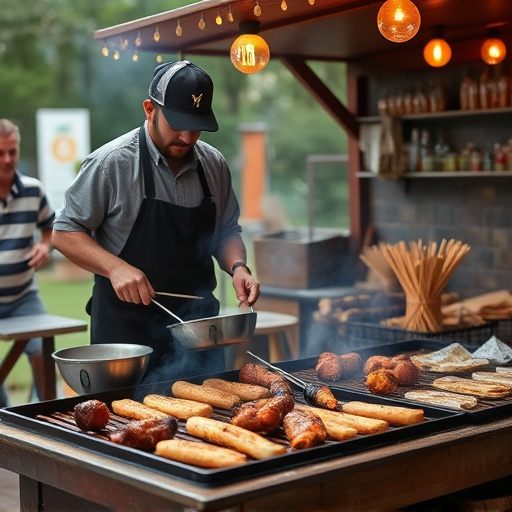
Dry brining is a critical step in achieving tender, flavorful smoked BBQ brisket. This technique involves massaging your brisket with a coarse salt mixture before slow-smoking it. By drawing out moisture and infusing salt’s natural preservatives, dry brining helps to break down tough connective tissues, resulting in incredibly tender meat.
It also enhances the brisket’s ability to absorb smoke flavors later on. For best results, apply your dry brine liberally – a good rule of thumb is about 2 tablespoons of coarse salt per pound of brisket. Rub it into every crevice and let it sit for several hours or even overnight in the refrigerator before smoking. This process will transform your brisket into a juicy, mouthwatering masterpiece that’s worth every minute of the wait.
Choosing the Best Smoker: Charcoal, Gas, or Electric for Consistent Results
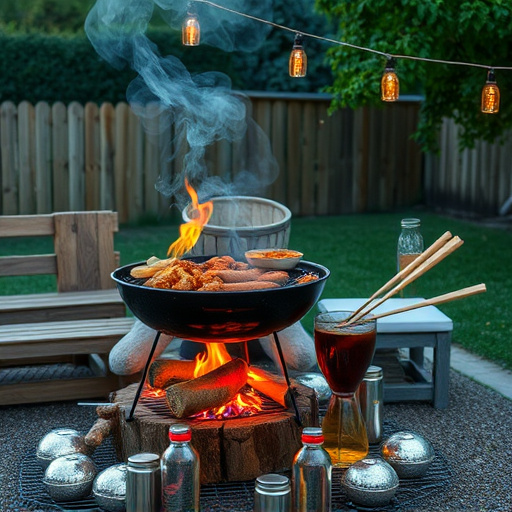
When crafting your perfect smoked BBQ brisket recipe, selecting the ideal smoker is a crucial first step. The options often revolve around charcoal, gas, or electric models, each offering unique advantages and nuances in taste. Charcoal smokers, beloved by many barbecue enthusiasts, provide a traditional experience with intense heat and robust smoke flavors. They require skill to manage temperature and fire, but the results can be spectacular. Gas smokers offer precision control, allowing you to adjust heat levels easily, making them ideal for beginners or those seeking consistent results without the hassle of managing fuel. Electric smokers, while convenient, may not deliver the same depth of smoke flavor but are excellent for maintaining steady temperatures, ensuring your brisket cooks evenly.
Choosing the right smoker depends on your experience level and desired outcome. Charcoal offers authentic, complex flavors, gas provides ease and precision, while electric guarantees even cooking. Experimenting with different types can help you decide, ultimately leading to your personal smoked BBQ brisket perfection.
Mastering Smoke Temperatures: Finding the Sweet Spot for Slow-Cooked Delicacy
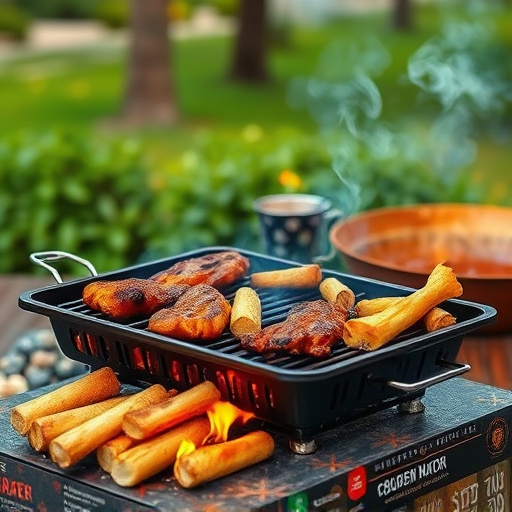
Achieving tender, perfectly smoked brisket requires an understanding of temperature control. The sweet spot for smoking BBQ brisket lies between 225°F to 250°F (107°C to 121°C). This range allows for slow, even cooking, transforming tough brisket muscle into a melt-in-your-mouth delicacy.
Maintaining consistent smoke temperature is key. Use a reliable smoker with good temperature control and regularly monitor the heat source. The ideal result is a slow-cooked brisket that develops deep, rich flavors from the gentle smoke, resulting in a smoked BBQ brisket recipe that’s truly exceptional.
The Art of Wood Chips and Smoking Times: A Guide to Achieving That Smoked Flavor
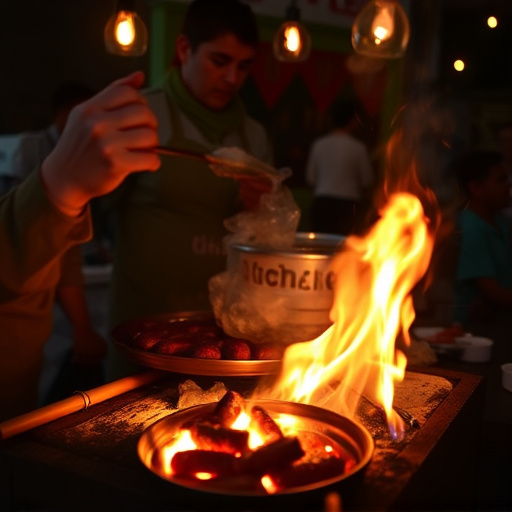
The key to achieving that mouthwatering, smoky brisket flavor lies in understanding the art of wood chips and smoking times. Different types of wood chips impart unique flavors, from sweet and fruity to robust and smoky. Oak, hickory, mesquite, and applewood are popular choices for BBQ brisket recipes, each offering distinct characteristics. The type of wood you choose should align with your preferred taste profile.
Smoking times vary based on several factors, including the cut of meat, temperature control, and the type of smoker used. As a general guide, brisket is best smoked at low and steady temperatures, around 225°F (107°C), for approximately 1 to 1.5 hours per pound. This slow process allows the smoke to deeply penetrate the meat, resulting in tender, juicy, and exquisitely smoky brisket. Experimentation and patience are key to mastering this culinary art form.
Resting Your Brisket: Why It's Crucial for Maximum Tenderness
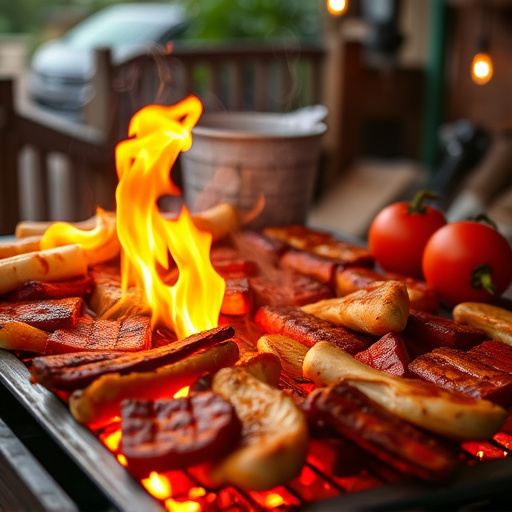
Resting your brisket is a crucial step in achieving tender, mouthwatering smoked BBQ brisket perfection. After slow-smoking for several hours, the muscle fibers in the brisket need time to relax and rehydrate. This resting period allows for maximum tenderness and helps distribute the smoky flavors evenly throughout the meat. During rest, the internal juices reform and redistribute, infusing every bite with rich, savory goodness.
For optimal results, allow your smoked brisket to rest undisturbed for at least an hour per pound, or until the internal temperature drops to around 105°F (41°C). This allows for proper meat resting and juiciness that will make your BBQ brisket recipe a true crowd-pleaser.
Slicing and Serving: Techniques for Presenting a Perfectly Cooked Brisket
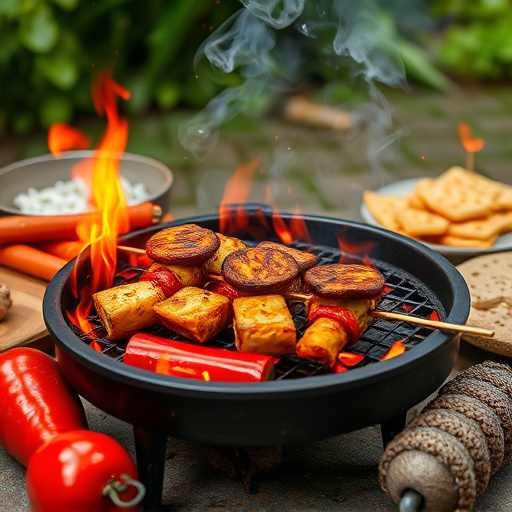
When it comes to serving your perfectly cooked smoked BBQ brisket recipe, the slicing technique is key to ensuring every bite is mouthwatering. Start by removing the brisket from the smoker and allowing it to rest for about 15-20 minutes before slicing. This resting period allows the juices to redistribute throughout the meat, making it incredibly tender. Using a sharp knife, slice the brisket thinly across the grain—this ensures each slice is lean and not too chewy.
For an impressive presentation, consider slicing the brisket into thin, even pieces and arranging them on a platter. You can also offer a variety of side dishes to complement your smoked BBQ brisket recipe, such as homemade salsa, coleslaw, or mashed potatoes. The goal is to showcase the beautiful marbling and tender texture of your brisket, making it the centrepiece of your meal.
